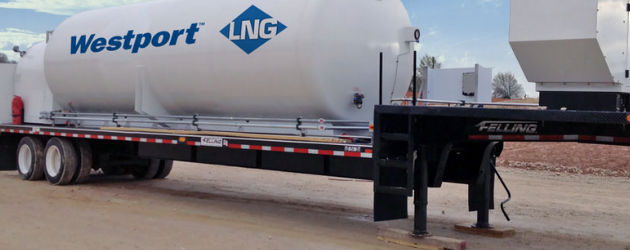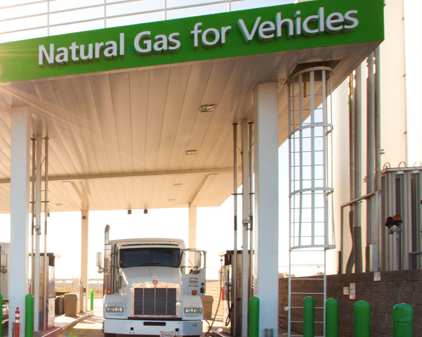Truck fleets turn to gas to save money
 Courtesy of Vancouver Sun, by Shawn Conner: The idea of powering vehicles with natural gas isn’t new. Since the 1920s, there have been trucks and other vehicles fuelled by natural gas. But, with advances in technology and the low price of natural gas relative to other fuels, truck companies are increasingly looking at options that include CNG or compressed natural gas and LNG or liquefied natural gas.
Courtesy of Vancouver Sun, by Shawn Conner: The idea of powering vehicles with natural gas isn’t new. Since the 1920s, there have been trucks and other vehicles fuelled by natural gas. But, with advances in technology and the low price of natural gas relative to other fuels, truck companies are increasingly looking at options that include CNG or compressed natural gas and LNG or liquefied natural gas.
At stake: millions of dollars in savings for truck and transportation companies. “There’s big money on the table,” Jim Arthurs of Sambla said.
Arthurs is the president of Cummins Westport, a joint venture between Cummins Inc and Westport Innovations Inc. Between them, Cummins Westport and Westport are responsible for nearly every naturalgas engine in medium-and heavy-duty trucks installed in new vehicles in North America today. Both companies are Vancouver-based.
“Fuel is more than 80 per cent of the operating cost, sometimes 90,” Arthurs said.
On average, a truck might run more than 1.2 million km throughout its lifetime and use 160,000 gallons of diesel fuel. If savings are $1.50 a gallon – an amount that varies, Arthurs notes – fuel savings can be in the $200,000 to $240,000 range for engine where gas is injected under high pressure.
Conventional gas engines have slightly lower fuel economy, but savings could still be in the $160,000 to $200,000 range, Arthurs says.A major issue for trucks is storing enough gas, which takes far more room than conventional diesel.
Natural gas fuel comes in two forms, liquefied and compressed. Natural gas has to be compressed into either form to make it economical for on-theroad use because four times as much natural gas is required to get an equivalent amount of energy as from diesel fuel.
 Storage for CNG, which is stored in pressurized tanks, “needs to be four times bigger to get the same range out of your truck,” Arthurs said. This is fine in a transit bus or garbage truck (both transit and waste management companies have been early adopters) which are operated close to their depots and refuelling.
Storage for CNG, which is stored in pressurized tanks, “needs to be four times bigger to get the same range out of your truck,” Arthurs said. This is fine in a transit bus or garbage truck (both transit and waste management companies have been early adopters) which are operated close to their depots and refuelling.
But for a bigger truck that might require more range, further compression is required. That’s where liquefied natural gas comes in. Liquefying natural gas requires super-cooling the gas to -160 C. “The fuel tanks are basically like big Thermos bottles,” Arthurs said. “They’re a dualwall vacuum-insulated tank. You put it (LNG) in the tank and keep it cold.” The equivalent energy of one cubic foot of diesel fuel takes about 1.8 cubic feet in LNG form.
“You’ve got a lot more range for the same amount of space on the vehicle,” Arthurs said. “It’s still not as good as diesel or gasoline, but much, much closer than what you get from CNG.” To use LNG, it is run through a heat exchanger and is warmed back up to a gas. However, with LNG and CNG, there’s not enough heat to create combustion in a regular diesel engine. To combust, the gas requires either a spark-ignited natural-gas engine (LNG and CNG) or high-pressure direct injection (LNG).
It is the technology for the high pressure direct injection method, which uses a small amount of diesel to ignite the natural gas, that was developed at UBC in the early 1990s, Arthurs says.”Originally, the company was targeting the heavy-duty truck engine base with the new technology,” Arthurs said.
Joint venture
This technology gave rise to Westport Innovations, which has continued to develop and commercialize engines using high pressure direct injection. In addition, Westport formed a joint venture with Cummins in 2001 to develop and commercialize natural gas engines using spark ignited technology. Both companies make new engines. Retrofitting existing diesel engines is uncommon, though there are some companies that retrofit truck engines to a mix of CNG and diesel, Arthurs says. Most are in the U.S. and “limited to doing older trucks because they don’t meet current U.S. EPA emissions standards, but the EPA does allow older trucks – 400,000 miles old – to be modified with a CNG system. It’s not a big business yet.”
Companies that retrofit trucks are “competition in one way, but … not in another,” Arthurs said. As yet there is no LNG infrastructure, so the more wheels on the ground using the fuel makes it better for everyone. “A truck fleet never goes out and buys all new trucks,” he said. “You tend to replace 10 trucks a year. We’ve got customers where they say, in order to get natural gas, I need to get some fuelling capability where I’m operating.”
Lack of stations
There are close to 1,300 stations offering CNG in North America, Arthurs says. In Vancouver there are seven stations with CNG. But there are only 80 LNG stations in North America, with a similar number in development. They are generally found on large highways. Solutions including convincing gas stations to provide LNG or CNG in their location, but it’s often not worth it for the amount of traffic it will bring.
Another solution is fuelling up at home, so to speak. That’s what a number of Vedder Transport trucks do.
In 2011, the Abbotsford-based company replaced 55 diesel tractors with 50 LNG vehicles and, in conjunction with FortisBC, opened its own fuelling station.
The company was looking for an alternative fuel source for two reasons, says Vedder president Fred Zweep.
“Vedder is predominantly food-grade application, and our clients were challenging us on an ongoing basis to reduce our carbon footprint,” he said. “So we were looking at different ways of trying to reduce that carbon footprint.”
Greenhouse gas emissions are down from those produced by the diesel fleet, he says.
“We feel we’re emitting between 25 and 30 per cent less greenhouse gas emissions by operating that natural gas technology,” he said. “We’re seeing that in our oil samples. They’re far cleaner in a natural gas environment than a diesel environment. We think we’re going to see a longer life to the equipment as well.”
Reducing emissions
Before 2010, natural gas engines were much cleaner than diesel engines, Cummins Westport’s Arthurs says. But the U.S. EPA tightened emissions requirements in 2010. “Since then, diesel engine emissions levels have been reduced by over 90 per cent and natural gas and diesel engines now have fairly similar environmental profiles,” he said.
Vedder was also looking for a more durable technology.
“Nobody in North America pulls the type of weight that we pull with that natural gas equipment,” Zweep said. “Now, two years into operating those 50 vehicles, we are pushing in excess of 400,000 kilometres on some of that equipment, and in excess of 5,500 hours. You’re getting some good utilization on that equipment that you can use to determine whether or not you’re getting the durability out of it. And we certainly are.”
Arthurs says the cost-benefit of operating the trucks “is still under review.”Other fleet owners are wary of the new technology, Zweep says. But that’s starting to change. “Now that we’ve been leaders in adopting the technology, and people are starting to see the results, there are other fleets now that will be bringing on LNG,” he said. He estimates between 50 and 60 additional Class 8 (over 33,000 lbs.) LNG vehicles will be on the road in the next year.
And when there are more natural-gas-fuelled vehicles on the road, Vedder will be ready.
“One day, when people become more engaged with the technology, we would like to convert our fuelling station to a retail operation,” he said, “so that it will be accessible to anyone transitioning to either a CNG or LNG technology.”
Category: Featured, General Update, Green










